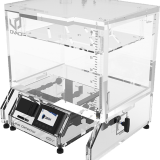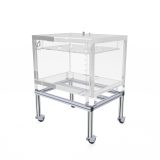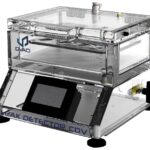The classic "bubble bath" or "water bath" or "immersion test"
This is the simplest and most widely used test for checking the tightness of flexible or rigid packaging.
The sample is immersed in the vacuum chamber. The chamber is evacuated and the vacuum causes the volume of air contained in the headspace of the packaging to increase. As it increases, it applies stress to the packaging’s sealing elements: sealing, heat-sealing, caps, stoppers, etc.
If a leak is detected, a column of bubbles forms at the exact location of the leak.
This test is simple to carry out and does not require a high level of technical expertise. This method is known as destructive, because it brings the product into contact with the water. If a leak is found, the water can penetrate the product and damage it.
Dry test with liquid flow
Another test method exists for containers that contain liquid and also air in the headspace. This air is very important to the success of the test.
The samples are placed in the chamber, in a horizontal position, slightly tilted towards their cap/pump… This ensures that the liquid contained in the packaging is in contact with the sealing element. An absorbent medium is placed under the samples to make it easier to see the liquid flow.
Once in this test position, the chamber is evacuated. This drop in pressure increases the volume of residual air in the headspace. As the air increases, it applies stress to the liquid contained in the packaging. As the liquid is incompressible, it applies the same stress to the sealing elements.
If there is a leak, the liquid will leak out. The absorbent media under the samples becomes impregnated with the liquid and the leaking samples can be easily isolated.
The dye penetration test or methylene blue test.
This test is generally used for small packages or packages with little air in the headspace.
In particular, this test is used for medical devices such as blisters, Tyvek bags, small ampoules, injectable vials, etc.
This test can follow the recommendations of standard ISO 8871-5 annex D.
The principle of the test is quite simple. The sample is immersed in a dye bath. The dye used is often methylene blue, which has a high colouring power. Once in the dye bath, the chamber is depressurised. The small amount of air contained in the packaging tries to escape through any leaks. The vacuum is maintained for a reasonable time, often around 10 minutes. We then return to atmospheric pressure. With the return to atmospheric pressure, the residual air volume returns to its initial volume and potentially sucks up the coloured liquid. Depending on the type and size of packaging, the penetration time is quite significant and should not be neglected. This phase lasts around 30 minutes minimum.
Once the penetration time is over, the packaging is wiped dry and rinsed to remove any traces of blue on the outside. We then check the condition of the inside of the pack, and if there are any traces of methylene blue, it means that there is a leak through which the coloured liquid has penetrated.







